 ... ...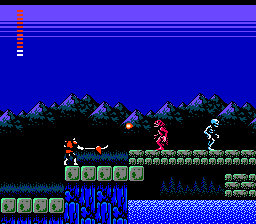
Castlevania 2: Simon's Quest is one of
the earliest NES classics and still one of the best. Although the
exploration style of gameplay did not appeal to everyone, I actually enjoyed
it very much. You
are Simon Belmont, and you must search Transylvania for the hidden pieces
of Dracula's body, then destroy them to prevent his evil curse from
destroying you.
Of all the
NES Castlevania games, I prefer the overall look of this game the most.
There's a good variety of settings, such as towns, churches, swamps,
forests, mansions, graveyards, and lakes. The settings are all drawn with
an amazing level detail and moody colors. Although the backgrounds inside the mansions are repetitive, there is still quite an impressive attention to detail, with subtle touches like the hanging skeletons, and the water above the mansion that is sunk beneath a lake. Castlevania 2 was one of the first games to include day and night
exploration. When night falls, some places, such as the towns and
graveyards, look even scarier. The enemies
are all large and colorful, and very fitting to the Castlevania theme, although the animation for some of them is somewhat stiff. (When the gargoyles and werewolves jump, they look like
they're bouncing.) Castlevania 2 more than meets the standard set by its predecessor for how good NES-style graphics can really be.
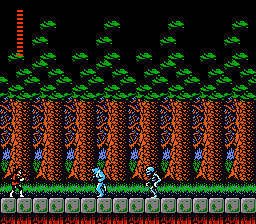 ... ...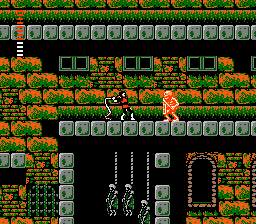
Bloody
Tears, Castlevania 2's main theme, is largely hailed as one of the best pieces of videogame music, and it's easy for me to understand why. Much like the graphics, the music fits the moody Transylvanian atmosphere perfectly. The only lackluster piece is the final boss music, which just doesn't sound exciting enough. The sound effects are all very good, and some are quite realistic. When you throw a bottle of holy water, it really sounds like glass
breaking as it hits the ground. If I had any real complaints about the sound, it's that there just aren't enough music themes. As good as "Dwelling of Doom" is, it becomes annoying when it's the only theme heard in the mansions (and I spent a lot of time exploring those mansions!)
Although it can take a bit to get used to the way Simon jumps, the play control in Castlevania 2 is very responsive and precise. Although there is some debate about the quality of the jumping control in the NES Castlevania series, for this installment, it's not really that important, since the game emphasizes
exploring and puzzle solving over making tricky jumps. Sometimes,
it can be a little frustrating in the mansions when you go to make
diagonal jumps. If you don't do it just right, you miss and fall all the
way down. It takes some practice, but I wouldn't call this game's play control "poor" at all.
 ... ...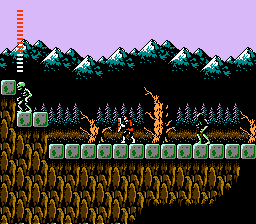
The backstory of Castlevania 2 is that Simon Belmont has defeated Dracula once,
but he now carries an evil curse. He must search the mansions of
Transylvania for the missing parts of Count Dracula, take them to his castle, and burn them to put an end to the curse and Dracula's evil, once
and for all. There are lots of
people to talk to in the towns, but most of them just give clues or say
things that make little, if any sense. (We've all probably heard of the "Graveyard Duck".) This is not really a bad thing, as useless chatter was never necessary in these kinds of games. There are even some programmer jokes thrown in, like one character who refers to the first Castlevania game by name. Despite its translation quirks, the gameplay of CV2 stays true to its storyline to the very end. And few games convery atmosphere as well as the Castlevania series does.
As far as actually defeating enemies and completing areas goes, Castlevania 2 is really not all that hard, and certainly nowhere near as difficult as its predecessor. As you
fight enemies and gain hearts, your experience level will go up,
increasing your life meter. You can also use the hearts to purchase
weapons, upgrades for your whip, and items, such as laurels that make you
invincible. The real challenge comes from
finding your way around the huge game world and solving all the puzzles.
There are some clues hidden in clue books and given by villagers that will
help you figure out some of the puzzles, but sometimes making sense out of them can be just as difficult as solving the problems all on your own. Some things can be figured
out easily by just trying different items and weapons in different
situations. As a result of these kinds of
conundrums within the game, many players get lost or stuck without using a
walkthrough. I don't distinctly remember using a walkthrough when I first played this game years ago, but I probably heard about some of the solutions by skimming through Nintendo Power or listening to people talk about the game. Castlevania 2 also has three different endings. Which one you
get depends on how much time it takes you to complete the game. So even if you've finished the game, this adds a bit of replay value. The game isn't too tough, but it's
baffling puzzles and huge areas will provide a decent challenge.
I really think the Castlevania style of
gameplay lends itself well to a sidescrolling adventure. The mansions
provide a decent challenge, and there are alot of areas to explore and
fight your way through. Another thing about the game that is unique, is
that it's somewhat non-linear. If you find yourself unable to complete one
mansion, you can usually look around and find another mansion to try
first. Some areas may have enemies that are too difficult to destroy until
you get your whip upgraded, but once you find the right weapons and items,
the entire game world opens up to you. There's a good variety of enemies, and each screen of the game world is packed with enough of them to keep you on your toes. My only real complaint is that the bosses, including the final boss, are pushovers. Otherwise, it's a great adventure game that never really gets
boring.
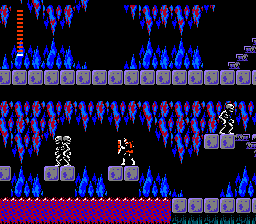 ... ...
Castlevania 2 is a true classic that mixes action,
adventure, and RPG elements very well. It's definitely worth a
try, and belongs in every NES gamer's library.
OVERALL
SCORE: 4/5
BACK TO NES
REVIEWS BACK TO MAIN
PAGE
|